Ishii and Echt

|
| Echt (エヒト) logo. Picture by JPG. (Image rights) |
Ishii Shōkai was a Japanese distributor in the 1930s and 1940s. It used the brand name Echt on a number of products, and was running a dependent manufacturing branch called Echt Kōgaku Kōgyō in the early 1940s.
Contents
History
The brand name Echt (エヒト, Ehito) was first used by the company Ishii Shōkai (石井商会) in the late 1930s. The January 1939 issue of Asahi Camera features Echt film magazines for 35mm cameras, distributed by Ishii.[1] Some months later, an advertisement dated December 1939 says that Ishii was the maker and distributor of the Echt products (エヒト製品製造発売元), and shows the ECHT logo, with the letters E, H, T circled by a large oval C.[2] The company was based in Ginza,[3] and was offering various high-end accessories mostly copied from the Zeiss Ikon range. The company was also selling genuine Zeiss products along with the domestically made copies.[2]

|
| Advertisement by Ishii Shōkai in Ars Camera March and April 1946. (Image rights) |
The Kraft 4×4 camera was made by the same company which made the Echt accessories. The official list of set prices compiled in October 1940 and published in January 1941 also mentions a camera called Echt (エヒト) along with the Kraft I and Kraft II, of which it was perhaps a name variant.[4] In January 1942, the Kraft camera and the Echt (エヒト) enlarger were jointly advertised by Echt Kōgaku Kōgyō Y.K. (ヱヒト光学工業有限会社, literally reading Ehito Kōgaku Kōgyō Y.K. and meaning Echt Optical Industries) and Y.K. Ishii Shōkai (有限会社石井商会, meaning Ishii Trading).[5] The two companies had the same physical address and were obviously closely related.[6] The company names indicate that Echt was the manufacturer and Ishii the distributor. (The April 1943 government inquiry on Japanese camera production mentions the Kraft camera as made by Ishii and distributed by Echt, but this was surely by mistake.)[7]
Ishii Shōkai survived the war, and placed advertisements in the March and April 1946 issues of Ars Camera.[8] These documents say that the company was ruled by Ishii Yūzō (石井有三), certainly the founder, and make no mention of the Echt products.
By 1955, the name of the company was K.K. Echt Shōkai (㈱エヒト商会).[9] It was selling an Echt exposure meter, which displays the same logo as the prewar and wartime accessories.[9] All trace of the company is lost after that date.
Mikami Makoto (三神誠), founder of the Matsushima camera distributor, was a former employee of Ishii, and Nukui Teikichi (貫井提吉), founder of the Nukui Labo repair shop, was a former employee or subcontractor working on Echt products.[10] The two men made acquaintance at Ishii, and it was Nukui who introduced Ogihara Akira (荻原彰), founder of Orion Seiki to Mikami, who would distribute Orion and Miranda products for various years.[10]
Cameras
- Echt (unconfirmed)
- Kraft I and Kraft II
Accessories
The most complex Echt device known so far is a copy stand for the Contax, called "automatic focusing copying device" (自動焦点式接写器). It is a close copy of the reproduction stand 5520/1 made by Zeiss Ikon. It comes in a black box, with two stages to contain the various components of the set. The green velvet lining inside the box lid shows the ECHT logo, the Japanese characters エヒト, the device name, the company name ECHT KOGAKU and the address GINZA TOKYO. The name ECHT WORKS is inscribed on the base of the copy stand, together with Echt's logo. The particular example pictured in this page has number 106 engraved at the back of the base and on the fixed and moving parts of the column, and number 282 engraved under the base. The device was certainly produced in very small numbers.
    
|
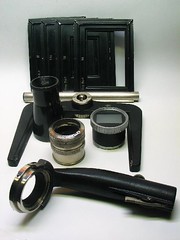 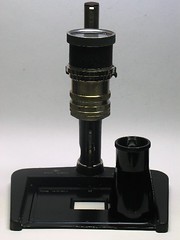 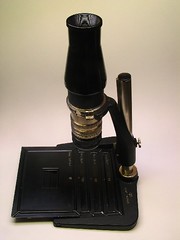
|
  
|
| Echt "automatic focusing copying device" for Contax. Pictures by JPG. (Image rights) |
Other Echt accessories have been observed:
- a set of filters for the Leitz Summar 5cm f/2 lens; it is contained in a box marked ECHT–Filtersatz and each individual filter is marked Summar 1:2 F5cm;
- a portable copy stand complete with close-up lenses, whose user manual shows the name "Echt repro device for Leica" (エヒトライカ用接写装置); it includes a special adapter ring for the Leitz Elmar 5cm f/3.5, marked ECHT Elmar 3.5; the name ECHT WORKS and the address GINZA TOKYO are inscribed inside the box, together with the ECHT logo and the Japanese characters エヒト.
Further accessories are known through original documents only:
- a complete close-up device for the 6×6 Super Ikonta (c.1939), said to "replace the Contameter" (コンタメーター代用), including a portable copy stand (similar to the "repro device for Leica" described above), close-up lenses and optical elements to correct the parallax and/or rangefinder adjustment;[2]
- close-up lenses alone (c.1939), similar to those included in the above sets;[2]
- a focusing rail (c.1939), apparently copied on a Zeiss Ikon accessory;[2]
- film cassettes for 35mm cameras (c.1939), available in Contax and Leica versions.[1][2]
- Echt exposure meter (sold ¥4,500 in 1955)[9]
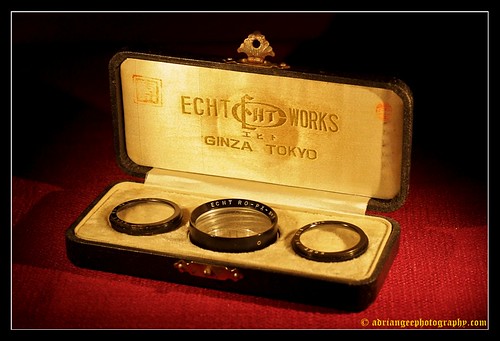
|
| TLR Close Up Kit 1 image by Adrian Gee (Image rights) |
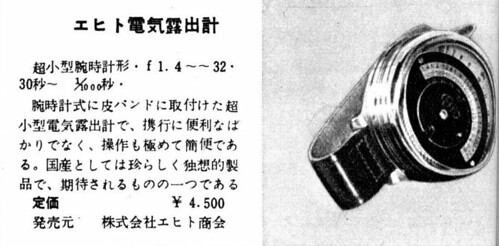
|
| Echt exposure meter in Photo Art no.80, June 1955. (Image rights) |
Notes
- ↑ 1.0 1.1 Column in Asahi Camera January 1939, p.189.
- ↑ 2.0 2.1 2.2 2.3 2.4 2.5 Advertisement on p.7 of Nihon Shashin Kōgyō Tsūshin, December 15, 1939, reproduced on p.41 of Hyaku-gō goto jūkai no kiroku.
- ↑ The address appears as Ginza 6–4 or as Ginza Nishi 6-chōme Taimei Shōgakkō Mae (座西六丁目泰明小学校前), "facing the Taimei school". Source: column in Asahi Camera January 1939, p.189, and advertisement on p.7 of Nihon Shashin Kōgyō Tsūshin, December 15, 1939.
- ↑ "Kokusan shashinki no kōtei kakaku", type 1, section 10.
- ↑ Advertisement in Shashin Bunka reproduced in Kokusan kamera no rekishi, p.68.
- ↑ The address of Echt was Tōkyō-shi Kyōbashi-ku Ginza Nishi-6-chōme (Kikuhon building) (東京市京橋区銀座西六丁目菊本ビル) and the address of Ishii was the same with no mention of the Kikuhon building. This was certainly the same physical location as in 1939.
- ↑ "Kokusan shashinki no genjōchōsa" ("Inquiry into Japanese cameras"), items 151–2.
- ↑ Advertisements in Ars Camera March 1946 (p.1) and April 1946 (p.1). The address was Tōkyō-to Kyōbashi-ku Ginza Nishi-6-chōme (Kikuhon building) (東京市京橋区銀座西六丁目菊本ビル). This was certainly the same physical location as in 1946.
- ↑ 9.0 9.1 9.2 Column in Photo Art no.80, June 1955, p.103.
- ↑ 10.0 10.1 Hagiya, p.10 of Kurashikku Kamera Senka no.64.
Bibliography
- Ars Camera. Advertisements by Ishii Shōkai in March 1946 (p.1) and April 1946 (p.1).
- Asahi Camera. "Atarashii kikai to zairyō" (新しい機械と材料, New equipment and materials), January 1939, pp.189–91. (Features Echt 35mm film magazines.)
- Asahi Camera (アサヒカメラ) editorial staff. Shōwa 10–40nen kōkoku ni miru kokusan kamera no rekishi (昭和10–40年広告にみる国産カメラの歴史, Japanese camera history as seen in advertisements, 1935–1965). Tokyo: Asahi Shinbunsha, 1994. ISBN 4-02-330312-7.
- Hagiya Takeshi (萩谷剛). "Miranda Sutōrī" (ミランダ・ストーリー, Miranda story). In Kamera Rebyū: Kurashikku Kamera Senka (カメラレビュー クラシックカメラ専科) / Camera Review: All about Historical Cameras no.64, June 2002. ISBN 4-257-13048-2. Miranda no keifu (ミランダの系譜, Miranda genealogy). Pp.9–12.
- "Kokusan shashinki no genjōchōsa" (国産写真機ノ現状調査, Inquiry into Japanese cameras), listing Japanese camera production as of April 1943. Reproduced in Supuringu kamera de ikou: Zen 69 kishu no shōkai to tsukaikata (スプリングカメラでいこう: 全69機種の紹介と使い方, Let's try spring cameras: Presentation and use of 69 machines). Tokyo: Shashinkogyo Syuppan-sha, 2004. ISBN 4-87956-072-3. Pp.180–7.
- "Kokusan shashinki no kōtei kakaku" (国産写真機の公定価格, Set prices of the Japanese cameras), listing Japanese camera production as of October 25, 1940 and setting the retail prices from December 10, 1940. Published in Asahi Camera January 1941 and reproduced in Shōwa 10—40nen kōkoku ni miru kokusan kamera no rekishi (昭和10〜40年広告にみる国産カメラの歴史, Japanese camera history as seen in advertisements, 1935—1965). Tokyo: Asahi Shinbunsha, 1994. ISBN 4-02-330312-7. Pp.108—9.
- Nihon Shashin Kōgyō Tsūshin (日本写真興業通信). Hyaku-gō goto jūkai no kiroku (百号ごと十回の記録, Ten records, every hundred issues). Tokyo: Nihon Shashin Kōgyō Tsūshin Sha (日本写真興業通信社), 1967. No ISBN number. Advertisement on p.41, corresponding to p.7 of the December 15, 1939 issue.
- Photo Art rinji zōkan: Kamera akusesarī zensho (フォトアート臨時増刊・カメラアクセサリー全書, Photo Art special issue: All the camera accessories). June 1955, no.80 of the magazine. "Denki roshutsukei" (電気露出計, Electric exposure meters). Pp.102–3.